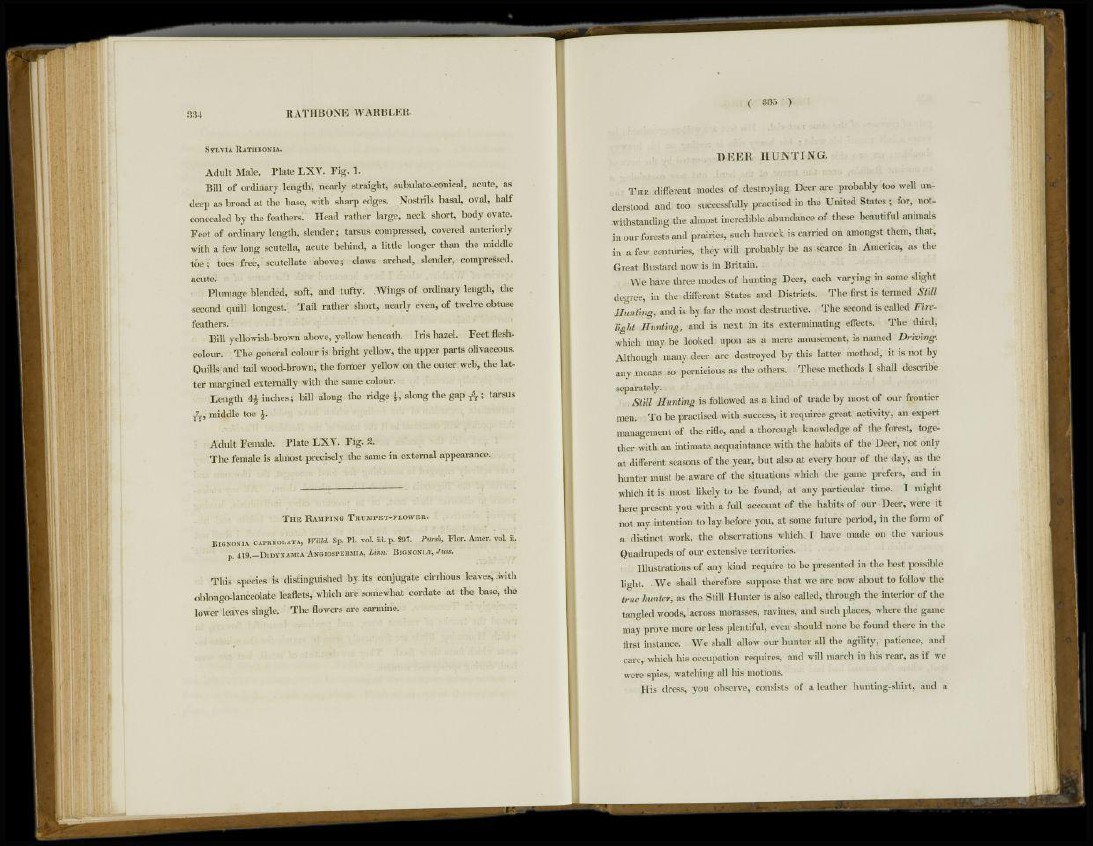
334 R A T H B O N E W A R B L E R.
SYLVIA HATHBOKIA.
Adult Male. Plate LXV. Fig. 1.
Bill of ordinary length, nearly straight, subulate-conical, acute, as
deep as broad at the base, with sharp edges. Nostrils basal, oval, half
concealed by the feathers. Head rather large, neck short, body ovate.
Feet of ordinary length, slender; tarsus compressed, covered anteriorly
with a few long scutella, acute behind, a little longer than the middle
toe; toes free, scutellate above; claws arched, slender, compressed,
acute.
Plumage blended, soft, and tufty. Wings of ordinary length, the
second quill longest. Tail rather short, nearly even, of twelve obtuse
feathers.
Bill yellowish-brown above, yellow beneath. Iris hazel. Feet fleshcolour.
The general colour is bright yellow, the upper parts olivaceous.
Quills and tail wood-brown, the former yellow on the outer web, the latter
margined externally with the same colour.
Length 4£ inches; bill along the ridge along the gap tarsus
T
7 j , middle toe
Adult Female. Plate LXV. Fig. 2.
The female is almost precisely the same in external appearance.
THE RAMPING TRUMPET-FLOWER.
BIGNONIA CAPREOLATA, Willd. Sp. PI. vol. iii. p. 297. Pursh, Flor. Amer. vol. ii.
p. 419.—DIDYSAMIA ANGIOSPERMIA, Linn. BIGNONI^E, JUSS.
This species is distinguished by its conjugate cirrhous leaves, with
oblongo-lanceolate leaflets, which are somewhat cordate at the base, the
lower leaves single. The flowers are carmine.
DEER HUNTING.
T H E different modes of destroying Deer are probably too well understood
and too successfully practised in the United States; for, notwithstanding
the almost incredible abundance of these beautiful animals
in our forests and prairies, such havock is carried on amongst them, that,
in a few centuries, they will probably be as scarce in America, as the
Great Bustard now is in Britain.
We have three modes of hunting Deer, each varying in some slight
degree, in the different States and Districts. The first is termed Still
Hunting, and is by far the most destructive. The second is called Firelight
Hunting, and is next in its exterminating effects. The third,
which may be looked upon as a mere amusement, is named Driving.
Although many deer are destroyed by this latter method, it is not by
any means so pernicious as the others. These methods I shall describe
separately.
Still Hunting is followed as a kind of trade by most of our frontier
men. To be practised with success, it requires great activity, an expert
management of the rifle, and a thorough knowledge of the forest, together
with an intimate acquaintance with the habits of the Deer, not only
at different seasons of the year, but also at every hour of the day, as the
hunter must be aware of the situations which the game prefers, and in
which it is most likely to be found, at any particular time. I might
here present you with a full account of the habits of our Deer, were it
not my intention to lay before you, at some future period, in the form of
a distinct work, the observations which. I have made on the various
Quadrupeds of our extensive territories.
Illustrations of any kind require to be presented in the best possible
light. We shall therefore suppose that we are now about to follow the
true hunter, as the Still Hunter is also called, through the interior of the
tangled woods, across morasses, ravines, and such places, where the game
may prove more or less plentiful, even should none be found there in the
first instance. We shall allow our hunter all the agility, patience, and
care, which his occupation requires, and will march in his rear, as if we
were spies, watching all his motions.
His dress, you observe, consists of a leather hunting-shirt, and a